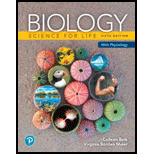
Biology: Science for Life with Physiology (6th Edition) (Belk, Border & Maier, The Biology: Science for Life Series, 5th Edition)
6th Edition
ISBN: 9780134555430
Author: Colleen Belk, Virginia Borden Maier
Publisher: PEARSON
expand_more
expand_more
format_list_bulleted
Question
Chapter 20, Problem 4LTB
Summary Introduction
Introduction:
The heart is the muscular organ which is approximately the size of one’s fist. It is located behind and slightly left of the breastbone. The function of the heart is to pump the blood by arteries and veins. The whole network of arteries, veins, and heart is termed as cardiovascular system.
Expert Solution & Answer
Want to see the full answer?
Check out a sample textbook solution
Students have asked these similar questions
Which of the following statements is true about hemoglobin?
a.hemoglobin
b. Each hemoglobin molecule is made up of one alpha and one beta chain polypeptide.
C. All that is needed to bind oxygen is a molecule of heme.
D. Each hemoglobin molecule can carry four oxygen molecules.
Hemoglobin will bind oxygen and release CO2 in places where there is a higher concentration of O2, lower concentration of CO2, lower temperature and lower acidity (as it is in lungs) and will do the reverse – release oxygen and bind CO2 - in places where there is a lower concentration of O2, higher concentration of CO2, higher temperature and higher acidity (as it is in working muscles).
True
False
While white blood cells never leave the circulation, red blood cells regularly leave it and travel by lymphatic system or find home in other tissues, e.g., lymph nodes, spleen, etc.
True
False
Blood clotting (coagulation) is a complex process involving many factors and it exhibits positive feedback loops: many of the factors also stimulate production of their own precursors.
B lymphocytes mature in the thymus while T lymphocytes mature in the bone marrow
True
False
Antibodies are molecules on the surfaces of foreign…
The following statement describes which level of structure of the hemoglobin molecule?
"Each chain is stabilized by electrostatic interactions between -COO- and -NH3+ of amino acid side chains."
Primary
Second
Tert
Quat
Chapter 20 Solutions
Biology: Science for Life with Physiology (6th Edition) (Belk, Border & Maier, The Biology: Science for Life Series, 5th Edition)
Ch. 20 - Describe how contraction of the diaphragm allows...Ch. 20 - Prob. 2LTBCh. 20 - Alveoli are ___________. small air sacs at the...Ch. 20 - Prob. 4LTBCh. 20 - Prob. 5LTBCh. 20 - Prob. 6LTBCh. 20 - Prob. 7LTBCh. 20 - Prob. 8LTBCh. 20 - Heart attacks ___________. are typically caused by...Ch. 20 - Prob. 10LTB
Knowledge Booster
Learn more about
Need a deep-dive on the concept behind this application? Look no further. Learn more about this topic, biology and related others by exploring similar questions and additional content below.Similar questions
- Which of the following are most closely associated with oxygen transport? (a) red blood cells (b) platelets (c) neutrophils (d) basophils (e) lymphocytesarrow_forwardWhen a person develops a fever, which of the following statements hemoglobin saturation are correct? - Modify the structure of hemoglobin and decrease its affernity for O2 - Can shift the O2-hemoglobin dissociation curve to the right - Decrease O2 unloading occurs in the tissue - Modify the structure of hemoglobin and increase its affernity for O2 - Can shift the O2 hemoglobin dissociation curve to the left - Enhance O2 unloading occurs in the tissuearrow_forwardWhich of the following would you LEAST expect to be associated with a low hematocrit? High altitude Low iron Low vitamin B12 Low levels of erythropoietin Valine substitution for a glutamate in ß-hemoglobinarrow_forward
- Which of the following situations occurs if a person's blood becomes more alkaline? A. Hemoglobin molecules retain less oxygen per heme group under alkaline conditions than they do at neutral pH or under acidic conditions. B. Hemoglobin molecules give up oxygen more readily under alkaline conditions than they do under neutral pH or under acidic conditions. C. Hemoglobin molecules change shape and begin to lose oxygen molecules. D. Hemoglobin molecules retain oxygen more readily under alkaline conditions than they do at neutral pH or under acidic conditions. E. There is no change in hemoglobin's oxygen-binding affinity under alkaline conditions when compared to blood at neutral pH or under acidic conditions.arrow_forwardEach hemoglobin molecule can combine with ____ molecule(s) of oxygen a. 4 b. 1 c. 3 d. 5 e. 2arrow_forwardDescribe the function of each of the following in hemoglobin. Fe; Distal His; Proximal His; Alpha/beta interface; Protoporphyrin IX;arrow_forward
arrow_back_ios
arrow_forward_ios
Recommended textbooks for you
 Human Physiology: From Cells to Systems (MindTap ...BiologyISBN:9781285866932Author:Lauralee SherwoodPublisher:Cengage Learning
Human Physiology: From Cells to Systems (MindTap ...BiologyISBN:9781285866932Author:Lauralee SherwoodPublisher:Cengage Learning Biology (MindTap Course List)BiologyISBN:9781337392938Author:Eldra Solomon, Charles Martin, Diana W. Martin, Linda R. BergPublisher:Cengage Learning
Biology (MindTap Course List)BiologyISBN:9781337392938Author:Eldra Solomon, Charles Martin, Diana W. Martin, Linda R. BergPublisher:Cengage Learning Human Biology (MindTap Course List)BiologyISBN:9781305112100Author:Cecie Starr, Beverly McMillanPublisher:Cengage Learning
Human Biology (MindTap Course List)BiologyISBN:9781305112100Author:Cecie Starr, Beverly McMillanPublisher:Cengage Learning Basic Clinical Lab Competencies for Respiratory C...NursingISBN:9781285244662Author:WhitePublisher:Cengage
Basic Clinical Lab Competencies for Respiratory C...NursingISBN:9781285244662Author:WhitePublisher:Cengage

Human Physiology: From Cells to Systems (MindTap ...
Biology
ISBN:9781285866932
Author:Lauralee Sherwood
Publisher:Cengage Learning


Biology (MindTap Course List)
Biology
ISBN:9781337392938
Author:Eldra Solomon, Charles Martin, Diana W. Martin, Linda R. Berg
Publisher:Cengage Learning

Human Biology (MindTap Course List)
Biology
ISBN:9781305112100
Author:Cecie Starr, Beverly McMillan
Publisher:Cengage Learning


Basic Clinical Lab Competencies for Respiratory C...
Nursing
ISBN:9781285244662
Author:White
Publisher:Cengage
Haematology - Red Blood Cell Life Cycle; Author: Armando Hasudungan;https://www.youtube.com/watch?v=cATQFej6oAc;License: Standard youtube license